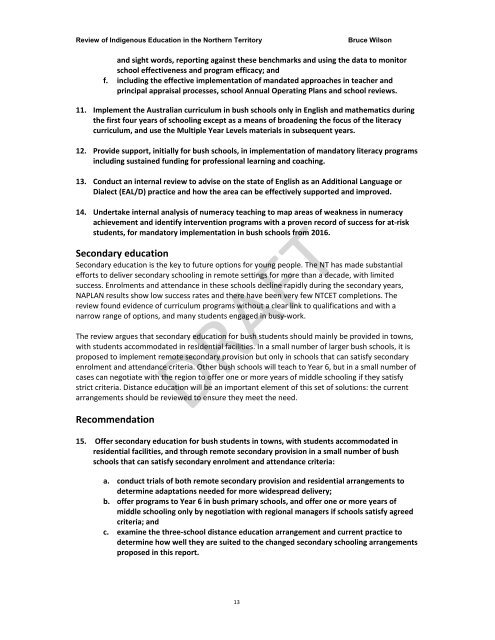Indigenous-Education-Review_DRAFT
Indigenous-Education-Review_DRAFT
Indigenous-Education-Review_DRAFT
You also want an ePaper? Increase the reach of your titles
YUMPU automatically turns print PDFs into web optimized ePapers that Google loves.
<strong>Review</strong> of <strong>Indigenous</strong> <strong>Education</strong> in the Northern Territory<br />
Bruce Wilson<br />
and sight words, reporting against these benchmarks and using the data to monitor<br />
school effectiveness and program efficacy; and<br />
f. including the effective implementation of mandated approaches in teacher and<br />
principal appraisal processes, school Annual Operating Plans and school reviews.<br />
11. Implement the Australian curriculum in bush schools only in English and mathematics during<br />
the first four years of schooling except as a means of broadening the focus of the literacy<br />
curriculum, and use the Multiple Year Levels materials in subsequent years.<br />
12. Provide support, initially for bush schools, in implementation of mandatory literacy programs<br />
including sustained funding for professional learning and coaching.<br />
13. Conduct an internal review to advise on the state of English as an Additional Language or<br />
Dialect (EAL/D) practice and how the area can be effectively supported and improved.<br />
14. Undertake internal analysis of numeracy teaching to map areas of weakness in numeracy<br />
achievement and identify intervention programs with a proven record of success for at‐risk<br />
students, for mandatory implementation in bush schools from 2016.<br />
Secondary education<br />
Secondary education is the key to future options for young people. The NT has made substantial<br />
efforts to deliver secondary schooling in remote settings for more than a decade, with limited<br />
success. Enrolments and attendance in these schools decline rapidly during the secondary years,<br />
NAPLAN results show low success rates and there have been very few NTCET completions. The<br />
review found evidence of curriculum programs without a clear link to qualifications and with a<br />
narrow range of options, and many students engaged in busy‐work.<br />
The review argues that secondary education for bush students should mainly be provided in towns,<br />
with students accommodated in residential facilities. In a small number of larger bush schools, it is<br />
proposed to implement remote secondary provision but only in schools that can satisfy secondary<br />
enrolment and attendance criteria. Other bush schools will teach to Year 6, but in a small number of<br />
cases can negotiate with the region to offer one or more years of middle schooling if they satisfy<br />
strict criteria. Distance education will be an important element of this set of solutions: the current<br />
arrangements should be reviewed to ensure they meet the need.<br />
Recommendation<br />
<strong>DRAFT</strong><br />
15. Offer secondary education for bush students in towns, with students accommodated in<br />
residential facilities, and through remote secondary provision in a small number of bush<br />
schools that can satisfy secondary enrolment and attendance criteria:<br />
a. conduct trials of both remote secondary provision and residential arrangements to<br />
determine adaptations needed for more widespread delivery;<br />
b. offer programs to Year 6 in bush primary schools, and offer one or more years of<br />
middle schooling only by negotiation with regional managers if schools satisfy agreed<br />
criteria; and<br />
c. examine the three‐school distance education arrangement and current practice to<br />
determine how well they are suited to the changed secondary schooling arrangements<br />
proposed in this report.<br />
13


